- cross-posted to:
- videos@hexbear.net
- communism@lemmygrad.ml
- cross-posted to:
- videos@hexbear.net
- communism@lemmygrad.ml
I genuinely do not understand how the mode of production in China differs from the U.S. In both countries we see commodities with use-vaule/exchange-vaule/value that are produced by privatized labor processes and that are made for profit rather than for direct consumption. Hence the exact same exploitation of the working class must be in place as the workers are paid a fraction of the value that they produce. Surplus-value is being appropriated in both countries.
Call China socialist if you like, the exploitation that Marx describes at the beginning of Capital is still there. On the other hand, here are the 12 points she mentions in the video:
(i) Limitation of private property through progressive taxation, heavy inheritance taxes, abolition of inheritance through collateral lines (brothers, nephews, etc.) forced loans, etc. (ii) Gradual expropriation of landowners, industrialists, railroad magnates and shipowners, partly through competition by state industry, partly directly through compensation in the form of bonds. (iii) Confiscation of the possessions of all emigrants and rebels against the majority of the people. (iv) Organization of labor or employment of proletarians on publicly owned land, in factories and workshops, with competition among the workers being abolished and with the factory owners, in so far as they still exist, being obliged to pay the same high wages as those paid by the state. (v) An equal obligation on all members of society to work until such time as private property has been completely abolished. Formation of industrial armies, especially for agriculture. (vi) Centralization of money and credit in the hands of the state through a national bank with state capital, and the suppression of all private banks and bankers. (vii) Increase in the number of national factories, workshops, railroads, ships; bringing new lands into cultivation and improvement of land already under cultivation – all in proportion to the growth of the capital and labor force at the disposal of the nation. (viii) Education of all children, from the moment they can leave their mother’s care, in national establishments at national cost. Education and production together. (ix) Construction, on public lands, of great palaces as communal dwellings for associated groups of citizens engaged in both industry and agriculture and combining in their way of life the advantages of urban and rural conditions while avoiding the one-sidedness and drawbacks of each. (x) Destruction of all unhealthy and jerry-built dwellings in urban districts. (xi) Equal inheritance rights for children born in and out of wedlock. (xii) Concentration of all means of transportation in the hands of the nation.
Unexpectedly, this roadmap only mentions commodity production vaguely. Someone who has read more please feel free to correct me as I find this discrepancy very confusing.
Socialism isn’t the absence of commodity production or private ownership, it’s a transitional mode of production where public ownership is the principle aspect and the state is under the control of the working clase. Those apply to China, whose large firms and key industries are overwhelmingly publicly owned, and private ownership is limited and gradually appropriated as China develops.
That’s helpful, thanks Cowbee. I know socialism is a transitional state but I thought that the bar was much much higher and/or the weeding out of private property/profit would happen faster by necessity. Which isn’t to downplay China’s achievements but it is confusing for someone just reading this stuff.
No problem. It’s important to recognize that they tried that already, under the Gang of Four, and it didn’t work as well because China wasn’t developed enough. It adopted more market reforms out of necessity, and it’s helping them move onto more developed stages of socialism faster. Here’s a diagram from Cheng Enfu that I find helpful:





